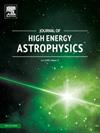二次引力中黑洞状致密物体周围的阴影和强引力透镜
IF 10.5
4区 物理与天体物理
Q1 ASTRONOMY & ASTROPHYSICS
引用次数: 0
摘要
我们研究了二次引力黑洞的天体物理后果,除了黑洞质量m之外,还有参数S0、S2、m0和m2。为了评估二次引力黑洞基本解的物理有效性,我们分析了它们在强偏转极限下的引力透镜特性。具体来说,我们利用M87和SgrA超大质量黑洞的观测数据,研究了二次引力黑洞投下的阴影,并约束了它的参数。我们的分析表明,在1σ置信水平内,二次引力黑洞的参数空间的很大一部分与事件视界望远镜(EHT)对M87和SgrA的观测结果一致。这表明,这些黑洞是描述天体物理学黑洞的合理候选者。作为一项额外的观测测试,我们对这些黑洞的强偏转极限特性进行了详细的研究。我们详细探讨了基本的透镜观测值,包括透镜图像的角位置和距离、相对放大倍数、最外层爱因斯坦环的半径以及图像之间的相对论性时间延迟。我们比较了二次引力黑洞对每个可观测值的预测与经典史瓦西解使用现实天体物理数据的预测。我们的发现为在银河系和星系外尺度上测试二次引力提供了一条途径,并在这个框架内为黑洞解的观测特性提供了新的见解。本文章由计算机程序翻译,如有差异,请以英文原文为准。
Shadows and strong gravitational lensing around black hole-like compact object in quadratic gravity
We investigate the astrophysical consequences of black holes in quadratic gravity, characterized by the parameters , , and , in addition to the black hole mass M. To evaluate the physical validity of the fundamental quadratic gravity black hole solutions, we analyze their gravitational lensing properties in the strong deflection limit. Specifically, we examine the shadow cast by the quadratic gravity black hole and constrain its parameters using observational data from the and supermassive black holes. Our analysis reveals that, within the 1σ confidence level, a significant portion of the parameter space for quadratic gravity black holes is consistent with the Event Horizon Telescope (EHT) observations of and . This suggests that these black holes are plausible candidates for describing astrophysical black holes. As an additional observational test, we perform a detailed investigation of the strong deflection limit properties of these black holes. We explore the fundamental lensing observables in detail, including the angular positions and separations of the lensed images, the relative magnifications, the radius of the outermost Einstein ring, and the relativistic time delay between images. We compare the predictions of the quadratic gravity black hole for each observable with those of the classical Schwarzschild solution using realistic astrophysical data. Our findings provide a pathway for testing quadratic gravity at the galactic and extragalactic scales, offering new insights into the observational properties of black hole solutions within this framework.
求助全文
通过发布文献求助,成功后即可免费获取论文全文。
去求助
来源期刊

Journal of High Energy Astrophysics
Earth and Planetary Sciences-Space and Planetary Science
CiteScore
9.70
自引率
5.30%
发文量
38
审稿时长
65 days
期刊介绍:
The journal welcomes manuscripts on theoretical models, simulations, and observations of highly energetic astrophysical objects both in our Galaxy and beyond. Among those, black holes at all scales, neutron stars, pulsars and their nebula, binaries, novae and supernovae, their remnants, active galaxies, and clusters are just a few examples. The journal will consider research across the whole electromagnetic spectrum, as well as research using various messengers, such as gravitational waves or neutrinos. Effects of high-energy phenomena on cosmology and star-formation, results from dedicated surveys expanding the knowledge of extreme environments, and astrophysical implications of dark matter are also welcomed topics.
 求助内容:
求助内容: 应助结果提醒方式:
应助结果提醒方式:


